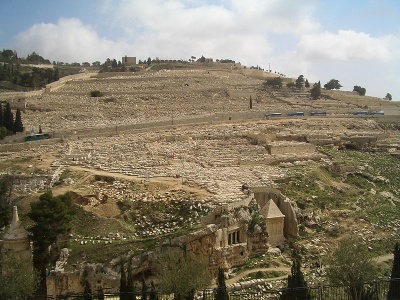The Testimony of Gethsemane - Part 1 - The Mount of Olives
While studying the account where Y'shua was praying at Gethsemane before his arrest, I was struck with how very emotionally intense it was and then how odd it seemed that he had taken his disciples with him only to separate himself from them. Was he motivated simply by a desire for a particular degree of privacy or was there some other reason? As I wondered and prayed, it came to me that the very location of the event typified separation. Indeed, even though such a thing is never stated directly, the entire Mount of Olives is a symbol of division and separation. As I checked every mention of this location in the Bible, this signification became very clear. Knowing that the Mount of Olives is always associated with division affords us greater insight, because all that the Bible records as being said and done on the Mount can be considered from that perspective. Though it may seem a small matter, this insight has led me to some very important lessons about the Lord's plans for the latter days of his church.
The Mount of Olives is mentioned by name 15 times in 14 verses. It is also referred to without being named in a couple other passages. Here are two mentions that are similar. Notice that Jesus separated himself from the other people - going to the Mount of Olives.
His activities were divided between the days in the temple and the nights on the Mount of Olives. He was with the people at the temple when they came to hear him, but otherwise segregated, residing at the mount.
Jesus dispatches his two disciples to free the donkey and her colt - two beasts of burden. The number two signifies division. #1 The disciples are separated from Jesus and the other disciples so that they can bring the donkey and her colt to Y'shua, who remained wherever he had been on the Mount of Olives. They untie the animals,  separating them from their present abode.
separating them from their present abode.
Why didn't the Lord just keep going and get the donkeys himself when he got there? I feel that the answer is somehow to be understood in relation to the theme of division and that it's an important matter with respect to its prophetic signification. It may be that the young colt represented his having to come a second time before he would be accepted, following the passage of a certain amount of time for the purpose of maturity. #2 (I want to note here that the riding of a donkey was not a lowly act, The donkey was the choice conveyance of kings.)
In Luke's account (as also in Mark 11) Bethany is mentioned along with Bethphage as the place where the donkeys would be found. According to J. B. Jackson, "Bethphage" means "green fig-house." Figs are a symbolic indicator of Israel, and their condition of ripeness seems an important consideration. This speaks of Israel's condition as a house of green figs, who were not yet ripe, or, mature in a spiritual sense - not yet ready to receive their King. #3 "Bethany" means "house of affliction." Affliction is a condition of pain, suffering, or distress. This is what Y'shua would shortly enter into because he was rejected by those whose acceptance was required, and, what the "house" of Israel would become because they refused their King, who would have otherwise brought them peace.
After the donkeys were brought to our Lord, he mounted up and rode toward the city of Jerusalem. A specific place on the Mount of Olives is then mentioned where there might have been a fork in the road or it simply began to descend down the mount. Observe how the people are divided when they get to that place.
There were many who accepted their King. But, on the other hand, there were those who would not acknowledge the King and humble themselves before him. The distinction made was recorded as taking place near where the road goes down the Mount of Olives. This is probably at the narrow neck or pass between the two pinnacles of the mount, the people were divided in the paramount matter of the identity of the one riding the donkey. He was their King and Messiah!
In the next set of passages, some very dramatic separations are noted: Jesus is physically / bodily separated from the Mount of Olives as he ascends into heaven and then, as he descends from heaven to the mount, tremendous physical / geological separations occur.
This was the manner of our Lord's separation from his disciples so that they would no longer see him or eat with him, etc. until his return. His coming back that same way from out of heaven to the Mount of Olives is recorded in Zechariah 14.
When he is physically rejoined to the Mount of Olives with his feet standing on it, the mount itself will be split in two, with the halves themselves separating from each other. The people who will be there will then be separated from the place as they flee by way of the newly formed valley. This event will follow after the pattern of the earthquake in the days of Uzziah.
This pair of references to the Mount of Olives seems to me to hold some very valuable keys to further insight. Since the mount is conspicuously named two times in Zechariah 14:4, the aspect of division seen there is even further emphasized.
The name of the mount isn't given in the specific verses I quoted from Acts, but rather appears in the next verse. Here is the passage that follows the account of our Lord's ascension.
The disciples had just been separated from the Lord because he had ascended into heaven, and now they separate themselves from the Mount of Olives by a distance noted as being a Sabbath day's walk. The symbolism in that degree of separation is striking as we observe that the Sabbath points to the seventh millennium, a time referred to as the Sabbath Day. That is when they will be bodily reunited with the Lord. From that perspective, it's not so much a matter of how far away they went as it is how long it will be. When that appointed time arrives, they will come to the New Jerusalem, the heavenly city. The upper room into which they came upon arrival is itself a symbol of that heavenly city. In the upper room, they all joined together constantly in prayer. Having left the Mount of Olives, and, upon coming to Jerusalem, there is a change from division and separation to that of unity, conspicuously marking a contrast in themes!
The next context in which we find the Mount of Olives named is that of the giving of the discourse usually referred to by association with that location. The dominant theme of the famous Olivet discourse is the separation of people. Notice that, first of all, the disciples separated themselves from the crowds as they came privately to him.
Deception will mark the time of the end as His coming approaches. Division will occur as many are deceived by the many who come in the name of Jesus Christ. We continue reading in the context about nation rising against nation, and kingdom against kingdom, the turning away of many from the faith, betraying and hating each other, the love of most growing cold but that those who stand firm to the end will be saved, and even the departure of those who are in Judea as they flee to the mountains. Then we read of the prominent separation as two men will be in the field; one will be taken and the other left. Two women will be grinding with a hand mill; one will be taken and the other left. Could division be more pronounced?
Consider how the series of parables found in the balance of the discourse reveals the basis for division between the owner of the house and the ones who watched, the faithful and wise servant and the wicked servant, the five foolish and the five wise virgins, and the various servants who stewarded the master's talents while he was away. Finally, note the son of man's activity as "he will separate the people one from another as a shepherd separates the sheep from the goats." Yes, division is so obviously the theme here!
In that account, we learned about the sheep being separated from the goats by the shepherd, but in the next, we will learn about sheep that are separated from the shepherd as they fall away on account of him. This, too, is declared while on the Mount of Olives.
Could the association between the Mount of Olives and the theme of separation be made more plain?
Although it is not mentioned by name, the Mount of Olives is referred to in Ezekiel 11.
If you read the surrounding context, you'll note numerous instances of division. Consider the prophetic application as you read. There is a vast distance to be observed between the rebellious idolaters and those in whom a new spirit is put. As the glory of the Lord went up from within the city of Jerusalem to stop over the Mount of Olives, the Spirit, as we can see now very pointedly, separated itself from that city and temple mount. Also, Ezekiel himself was separated from the people of Jerusalem by the spirit while it was stopped above the Mount of Olives.
I found Matthew Henry's Commentary note on the passage rather insightful in this regard. "Here is, 1. The departure of God's presence from the city and temple. When the message was committed to the prophet, and he was fully apprised of it, fully instructed how to separate between the precious and the vile, then the cherubim lifted up their wings and the wheels beside them (v. 22) as before, <Ezekiel 10:19>. He noted the departure of God's presence from the city and temple, causing the separation between them, and further noted that the prophet was fully instructed how to separate between the precious and the vile.
Today, the people have largely been brought back into the land as those who desire to do so have been given plenty of opportunity. The prophecy will shortly apply when the vile images and detestable idols have been removed and the 144,000 are sealed. The rabbi Janna has noted a fascinating historical tradition which has a parallel in our Lord's earthly ministry and with what appears to me to be the time of special ministry of the 144,000 and the two witnesses. It is believed that the shekhinah glory stood 3 1/2 years upon the Mount of Olives preaching and saying, "Seek ye the Lord while he may be found, call ye upon him while he is near. As a wise man once declared:
The next account I'm going to expound exhibits such parallels that every one of the other accounts seems to be encompassed in its scope. It is the first place the Mount of Olives is mentioned by name in the Bible so it's actually kind of an introductory overview. I've saved it for last so that we can consider it with the benefit of familiarity with the other accounts. Just as there are many parallels which compare in agreement, there are many contrasts that are no less a teaching tool than those items in accord. Here are the focal verses from the passage.
You should read the 15th and 16th chapters to get an idea of what is happening in the surrounding context.
This passage compares with the initial scriptures I discussed (Luke 21:37, John 7:53-8:1) in that people are separated from each other simply by where they go. In those accounts the Messiah went to the Mount of Olives; here, David, a type of the Messiah, went to the Mount. Notice that the typical and the antitypical kings were both being actively sought after to be killed in a conspiracy to deprive them of their throne.
The second set of scriptures I discussed dealt with the donkeys being delivered so that the king could ride. We find this in II Samuel 16.
The next scriptures I addressed were part of the same event but focused on the response of the people to the king who rode the donkey. Some accepted their king and some rejected him. The congruence between the records on this point is obvious.
Following that, the ascension and descent (the coming again in like manner as he departed into heaven) of our Lord were the focal topics. I see the ascension encoded into the record of II Samuel as the ark is taken to Jerusalem. The ark is a messianic symbol. An ark is a box, a container for the glory of God. Jerusalem symbolizes the abode of Yahweh - heaven, or, the new Jerusalem. #4 So, we see, as the priests carry the ark to Jerusalem, a symbolic representation of the Messiah being conveyed to his Father's home. The mention of David's barefoot condition brings to my mind Zechariah 14:4, mentioning Y'shua's feet as they will stand upon the Mount of Olives when he descends some day not long hence.
Then, in parallel with the account in Acts 1, we see people returning to Jerusalem from the hill called the Mount of Olives.
The next congruity I'd like to point out is as the account compares with the Olivet discourse. Both contexts show the division of the people. In II Samuel, David sorts them out as to where they should and shouldn't go. After that, we read about the sheep being separated from the shepherd as they fall away on account of him. David, the shepherd boy who grew to become king was finding this very thing happening to him!
Finally, we see another parallel to the glory of the Lord that was seen by Ezekiel as it departed from the temple and the city and stopped above the mountain east of it. David, representing the glory of the Lord as Yahweh remained with him, left Jerusalem and went up the mountain east of it.
It's a rather curious matter, but you can note how each subsequent reference to the Mount of Olives has a matching element within the context of that first mention of the mount, so it apears as something of a table of contents.
At this point in the study I'd like to point out another curious matter involving the first verse I presented at the outset.
Notice how the sentence has been broken in two, with the division marking a new verse AND a new chapter. The chapter number, eight, is the number that signifies a new beginning. I believe the author of the scriptures watches over His Word, even its verse and chapter divisions! This verse speaks to that very loudly to me!
There are many parallels in the account of II Samuel to what transpired on the mount of Olives at the place known as Gethsemane, near the base of the mount on the Western slope. The things done and said at Gethsemane are of great consequence to you and I, who stand on the threshold of the seventh millennium. These are the subject of a separate and extensive study, a study that picks up and extends the theme of division so evident in the greater context of its location, that of the Mount of Olives.
End notes:
1) The primary part of what is known as the Mount of Olives has what the International Standard Bible Encyclopaedia calls, "two principal summits and two subsidiary spurs." The northern summit is "separated from the southern summit by a narrow neck..." So it is that this mount's very topology is marked by the number two - division! The Mount of Olives is separated from the temple mount by the Kidron valley, in which the seasonal kidron brook sometimes runs. The name "Kidron" means: the mourner: the black one. In the time of our Lord, a two arched bridge spanned the Kidron and connected the Mount of Olives to the East Gate of the Temple Mount.
return
2) Genesis 49:11 "He will tether his donkey to a vine, his colt to the choicest branch; he will wash his garments in wine, his robes in the blood of grapes." return
3) In Song of Solomon 2:13, the KJV renders the Hebrew "green figs" in KJV . It is "pag" in the Hebrew, Strong's #6291: pag; from an unused root mean. to be torpid, i.e. crude; an unripe fig.:--green fig. return
4) See Revelation 3:12, 21:2, 10, Luke 9:51, and Hebrews 12:22. Consider also from a few verses earlier in the account of II Samuel 15 - verse 25 "Then the king said to Zadok, "Take the ark of God back into the city. If I find favor in the Lord's eyes, he will bring me back and let me see it and his dwelling place again." The city where they were taking the ark represented God's dwelling place - heaven! This is the city with foundations Abraham looked forward to. (Hebrews 11:10) return
 HD Video
HD Video mp3 Audio Download
mp3 Audio Download